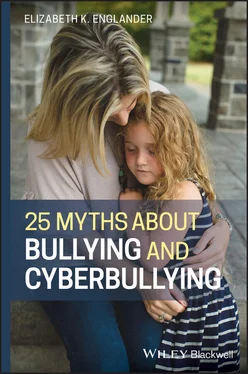So in this book, instead of staking out absolute “factual” positions (i.e. it is true or it isn't true ), I'm going to take a look at both the most recent trends in bullying and cyberbullying research and the complexity that defines 25 of the most common myths. Dealing with bullying and cyberbullying is all about prevention and strategy; and because, frankly, it's not always a 100% fixable problem, it's also about increasing coping skills, social support, and resiliency. The questions we ask our children and the assumptions we make have a big impact on the tactics we discuss with our kids and the success they ultimately have.
My own vantage point is somewhat unique. I'm a researcher and a professor, and my 30 years of research and teaching focus on bullying, aggression, and digital technology (a somewhat odd, but actually quite useful, combination). I'm also a parent who's had to deal with my own children's experiences of social cruelty, as well as deal with all the chaos, tension, and difficulty surrounding the use of digital technology in any home with modern kids. My experience as a mother has taught me how challenging and frustrating this issue can be and how much we can long for fast, easy, ripping‐off‐the‐Band‐Aid solutions. I know how hard it is to see my kids feeling hurt, and how tempting it is to try to fix everything for them. But it's my longstanding professional interest as a researcher and a teacher, and my relationships with colleagues both in North America and in Europe, that have most strongly guided my perspective. When considering how to help children with these problems, I think it's critical to take into account how kids develop and how digital technology really impacts human communication and human relationships. It's the juxtaposition of these two areas of knowledge that I'll bring to this book. If your expectation is an instant resolution, you should know up front that this problem can defy quick solutions. But there is relief to be had . Not perfection – but relief.
You may find yourself wanting to hold unto some of the myths I describe here. It's important to remember that myths about bullying and cyberbullying aren't fantasies, make‐believe, silly, or baseless. It's easy to dismiss myths that have no history of real evidence: you probably know that the Earth isn't flat and that crossing your eyes doesn't make them stick that way. It's a lot more difficult to dismiss beliefs or strategies that were once essentially correct, but that aren't today. As the world shifts and changes, explanations that were spot‐on a generation ago can indeed become completely wrong – sometimes dismayingly so. Fifty years ago, an American with only a high school diploma could land a job that would enable him or her to maintain a middle‐class lifestyle. But today, it would be a myth to say that a high school education is all you need to live in the middle class. The rapidity of these types of social changes is why myths about bullying and cyberbullying can be among the toughest to challenge. Let's get started.
1 1DiIulio Jr., J.J. (1995). Moral poverty: The coming of the super‐predators should scare us into wanting to get to the root causes of crime a lot faster. Chicago Tribune (15 December), p. 31.
2 2C.S. Mott Children’s Hospital. (2017). Mott Poll report: Bullying and internet safety are top health concerns for parents. https://mottpoll.org/reports‐surveys/bullying‐and‐internet‐safety‐are‐top‐health‐concerns‐parents.
3 3Bully Police USA. (2017). www.bullypolice.org.
4 4I wasn't able to resist pointing out to her that adults share many, many things – a home, money, bathrooms, childrearing decisions, daily chores, etc.
5 5Wolke, D. and Lereya, S.T. (2015). Long‐term effects of bullying. Archives of Disease in Childhood 100 (9): 879–885. https://doi.org/10.1136/archdischild‐2014‐306667.
Chapter 2 Myth #1: Bullying is usually about a big kid beating up a smaller kid.
The deadliest animal in the world isn't the crocodile or the bear – it's actually the mosquito. 1 This persistent, tiny pest kills much more effectively and efficiently than any enraged bear by simply carrying malaria, yellow fever, and other blood‐borne illnesses. But while we're not likely to hear a tabloid news story about an outbreak of malaria, a bear attack on a few hikers is much more dramatic and makes much better news copy (even if it is statistically far less lethal). In 2016, many news outlets carried the sad story of a well‐liked Forest Service officer who was suddenly killed by a bear in Montana; in the same year, thousands of people died from malaria in Tanzania alone. 2
In a similar way, severe incidents of physical attacks and bullying might be the most salient and noticeable, but it's that persistent and contemporary pest – psychological bullying – that really affects most of us. Yet until relatively recently, most researchers and educators focused on the type of bullying that was most evident and easiest to detect: physical harassment that happened on school grounds. Even as recently as 2015, the very first item on the National Education Association's list of “signs of bullying” was “torn clothes,” despite overwhelming data that psychological injuries prevail. 3
The fact is that physical bullying is in many ways easier to address, because it simplifies and clarifies the role adults should play and how they can respond. Although it's not always a simple task to spot a bullying situation when the bullying is psychological, detecting physical bullying isn't as hard – there are obvious, concrete signs. The relatively less complex nature of physical bullying makes it a tempting area for our focus, and the more difficult job of assessing psychological damage tempts us to brush it aside.
It's important, though, to keep your eye on the ball. A slew of research has overwhelmingly concluded that most bullying happening in the third decade of the twenty‐first century is, indeed, psychological in nature – either verbal or relational, in person, or through digital technology. 4 In one of my own research studies, where I've examined thousands of 18‐year‐olds at the university where I've taught for many years, I've found exactly that same pattern. I've also studied more than 50,000 children aged 8–18, and those findings agree; far more children report being psychologically victimized by bullies, compared to the number who report that they're being physically targeted. Just as psychological bullying appears to be gaining in popularity, physical bullying seems to be declining precipitously. 5 It hasn't completely disappeared, but it's most definitely taken a back seat to its sneakier, less apparent but arguably more damaging cousin. 6 These findings are far from isolated. Other researchers have noted the same trend. 7 , 8 , 9
The fact that most bullying today is psychological probably represents a major social shift, the result of profound changes in how we raise children, our tolerance of aggression, and the role of digital technology. Back when physical bullying was the focus, a child's size had real implications for becoming a bully. A 1998 study of three‐year‐olds found that preschoolers who were at least half an inch taller than their peers were actually more likely to be physically aggressive at age 11. 10 Attacking or threatening your target with physical violence carried with it certain implications – the primary one being that when you used physical bullying, you had to carry out your bullying away from adult eyes. Avoiding adults is less of a problem for today's bullies. This is ironic, considering that children today are more closely supervised, spend less time away from adults, and generally find that adults tolerate aggression less than they once did. I think that most modern parents (myself included) approve of supervision and less aggression. But these positive social changes have also incurred a cost. While more supervision and less tolerance for aggression have hampered physical bullying, they may have also motivated bullies to perfect psychological tactics in the social power dance. “Game of Thrones” – the school edition – persists, and psychological attacks are, unfortunately, much more advantageous. For one thing, they can be carried out right in front of adults through the use of subtle behaviors and through digital technology, which, despite its myriad rewards, has (it must be admitted) helped facilitate this type of problem. 11
Читать дальше












